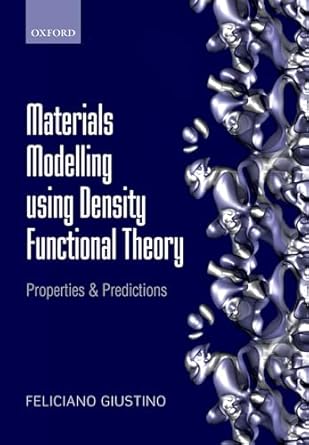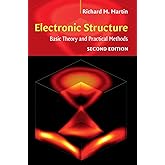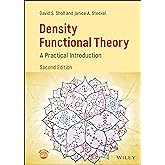This is an outstanding monograph on the background and use of density functional theory (DFT) in materials science. Dr. Feliciano Giustino has written a textbook that it is accessible to students in an undergraduate physics or a graduate physics/materials science program. However a dedicated and passionate undergraduate in chemistry or materials science may also find this book of interest. The main theme of this text is not to focus on the theoretical development behind DFT but on the outcomes and various approximations that enable us to study the structures and properties as it relates to materials. The authors does this by including useful exercises and results from DFT calculations to further illustrate the predictive capabilities of the derived theories.
The book is extremely well organized with the more advanced topics such as dielectric and magnetic properties left to the last two chapters. Chapters 1-4 start with the basics outcomes of quantum mechanics and the Kohn-Sham/Kohn-Hohenberg theorems (i.e. DFT). In Chapters 5-8 the author focuses on the predictions made by DFT with regards to structure and elastic/vibrational properties. Dr. Feliciano Giustino does a really good job at linking DFT predictions to experimental measurements by using case-studies from literature. Chapter 9 focuses on the calculation of electronic bandstructures and DFT's shortcomings. Finally, in chapters 10 and 11 the author explains the theory and use of DFT to calculate the dielectric and magnetic properties of materials. These last two chapters are intended to be a light introduction and many references are given for the enthusiastic reader.
What makes this book so fantastic is the how well it is written. The author leaves no ambiguity to the outcomes and interpretation of DFT. I also really like how Dr. Feliciano Giustino always includes direct references to relevant literature, thereby ensuring that the advanced or curious reader is able to expand upon the theories discussed in the text. Toward this end, I will note that if its been some time since you've studied quantum mechanics or solid state physics you should have the following standard textbooks at your side while reading this: Quantum Mechanics by E. Merzbacher, Solid State Physics by Ashcroft and Mermin, and Introduction to Solid State Physics by Kittel. The author refers to these references numerous times throughout this textbook.
This book is not a “how-to” guide to running DFT calculations. For that your best-off using a book like Computational Material Science by June Gunn Lee. I do think it would be worth Dr. Feliciano Giustino's time to develop an independent “workbook” to accompany this text whereby he demonstrates how to perform many of the DFT calculations which are covered and highlighted in this text. Ideally this would be best done with an open-source DFT code. This could then be adapted by an instructor or the independent learner to use as a “hands-on” teaching guide; this is probably more pertinent for the independent learner. I think this is important for three reasons:
1. It helps the reader better grasp the unclear nomenclature associated with calculation outputs from DFT codes.
2. The nuances associated with running any DFT calculation such as tolerances, cutoff energies, k-space integration, smearing, etc.
3. Differences in predictions between the various basis sets, exchange-correlation functionals, and pseudopotentials.
Overall I strongly recommend this book!

Download the free Kindle app and start reading Kindle books instantly on your smartphone, tablet, or computer - no Kindle device required.
Read instantly on your browser with Kindle for Web.
Using your mobile phone camera - scan the code below and download the Kindle app.

Materials Modelling using Density Functional Theory: Properties and Predictions
by
Feliciano Giustino
(Author)
Sorry, there was a problem loading this page. Try again.
This book is an introduction to the quantum theory of materials and first-principles computational materials modelling. It explains how to use density functional theory as a practical tool for calculating the properties of materials without using any empirical parameters. The structural, mechanical, optical, electrical, and magnetic properties of materials are described within a single unified conceptual framework, rooted in the Schrodinger equation of quantum mechanics, and powered by density functional theory.
This book is intended for senior undergraduate and first-year graduate students in materials science, physics, chemistry, and engineering who are approaching for the first time the study of materials at the atomic scale. The inspiring principle of the book is borrowed from one of the slogans of the Perl programming language, 'Easy things should be easy and hard things should be possible'. Following this philosophy, emphasis is placed on the unifying concepts, and on the frequent use of simple heuristic arguments to build on one's own intuition. The presentation style is somewhat cross disciplinary; an attempt is made to seamlessly combine materials science, quantum mechanics, electrodynamics, and numerical analysis, without using a compartmentalized approach. Each chapter is accompanied by an extensive set of references to the original scientific literature and by exercises where all key steps and final results are indicated in order to facilitate learning. This book can be used either as a complement to the quantum theory of materials, or as a primer in modern techniques of computational materials modelling using density functional theory.
This book is intended for senior undergraduate and first-year graduate students in materials science, physics, chemistry, and engineering who are approaching for the first time the study of materials at the atomic scale. The inspiring principle of the book is borrowed from one of the slogans of the Perl programming language, 'Easy things should be easy and hard things should be possible'. Following this philosophy, emphasis is placed on the unifying concepts, and on the frequent use of simple heuristic arguments to build on one's own intuition. The presentation style is somewhat cross disciplinary; an attempt is made to seamlessly combine materials science, quantum mechanics, electrodynamics, and numerical analysis, without using a compartmentalized approach. Each chapter is accompanied by an extensive set of references to the original scientific literature and by exercises where all key steps and final results are indicated in order to facilitate learning. This book can be used either as a complement to the quantum theory of materials, or as a primer in modern techniques of computational materials modelling using density functional theory.
- ISBN-100199662444
- ISBN-13978-0199662449
- PublisherOxford University Press
- Publication dateJuly 15, 2014
- LanguageEnglish
- Dimensions10.1 x 7.2 x 0.8 inches
- Print length286 pages
Customers who bought this item also bought
Page 1 of 1 Start overPage 1 of 1
Editorial Reviews
Review
"At last an undergraduate/graduate textbook that demonstrates the power of density functional theory not only to help interpret experimental data but also to predict the properties of new materials. Each chapter is lucidly presented with heuristic, intuitive arguments leading to the main ideas before numerous examples illustrate the often remarkable accuracy of density functional theory over a wide range of electronic, structural, mechanical, optical and magnetic properties. A book that should be on the shelves of every library in Materials Science and Engineering, Physics and Chemistry departments." --David Pettifor, University of Oxford "The density functional theory has finally brought quantum mechanics into materials science. Its proven ability to produce correct predictions of properties of real materials means that it has taken over as the premier method in solid state materials, ultimately because of its suitability as a numerical method. While traditional books still build from analytically tractable models, this book reflects more accurately current practice. The book will be ideal for a graduate-level student with a grounding in quantum mechanics, and could be tackled in an undergraduate course." --Graeme Ackland, University of Edinburgh
Book Description
The book explains the fundamental ideas of density functional theory, and how this theory can be used as a powerful method for explaining and even predicting the properties of materials with stunning accuracy.
About the Author
Feliciano Giustino, University Lecturer, Department of Materials, University of Oxford
Feliciano Giustino is a University Lecturer in the Department of Materials at the University of Oxford, the co-Director of the Materials Modelling Laboratory, and Associate Editor of the European Physical Journal B. He holds an MSc in Nuclear Engineering from the Politecnico di Torino, a PhD in Physics from the Ecole Polytechnique Federale de Lausanne, and before joining the Department of Materials at Oxford he was a researcher in the Department of Physics at the University of California at Berkeley. His research team specializes in the computational modelling of nanomaterials and the development of methods for electronic structure calculations. He has been recipient of the European Research Council Starting Grant and of the Leverhulme Research Leadership Award. Besides his research work, he teaches two undergraduate courses on the quantum theory of materials at the University of Oxford.
Feliciano Giustino is a University Lecturer in the Department of Materials at the University of Oxford, the co-Director of the Materials Modelling Laboratory, and Associate Editor of the European Physical Journal B. He holds an MSc in Nuclear Engineering from the Politecnico di Torino, a PhD in Physics from the Ecole Polytechnique Federale de Lausanne, and before joining the Department of Materials at Oxford he was a researcher in the Department of Physics at the University of California at Berkeley. His research team specializes in the computational modelling of nanomaterials and the development of methods for electronic structure calculations. He has been recipient of the European Research Council Starting Grant and of the Leverhulme Research Leadership Award. Besides his research work, he teaches two undergraduate courses on the quantum theory of materials at the University of Oxford.
Product details
- Publisher : Oxford University Press (July 15, 2014)
- Language : English
- Paperback : 286 pages
- ISBN-10 : 0199662444
- ISBN-13 : 978-0199662449
- Item Weight : 1.65 pounds
- Dimensions : 10.1 x 7.2 x 0.8 inches
- Best Sellers Rank: #243,575 in Books (See Top 100 in Books)
- #39 in Materials Science (Books)
- #74 in Mathematical Physics (Books)
- #1,080 in Core
- Customer Reviews:
Customer reviews
4.6 out of 5 stars
4.6 out of 5
44 global ratings
How customer reviews and ratings work
Customer Reviews, including Product Star Ratings help customers to learn more about the product and decide whether it is the right product for them.
To calculate the overall star rating and percentage breakdown by star, we don’t use a simple average. Instead, our system considers things like how recent a review is and if the reviewer bought the item on Amazon. It also analyzed reviews to verify trustworthiness.
Learn more how customers reviews work on AmazonReviews with images
3 out of 5 stars
A Good Introduction to DFT
The book did not meet my expectations in purchasing it: To learn HOW TO model materials using DFT.This book is a beautiful introduction to DFT plus lots of useful references.However it FAILED to show one HOW TO use Quantum ESPRESSO and other software that implement DFT.It also failed to show how DFT could be used to design SUPERCONDUCTORS, my field of deep interest.The book is well organised, well written, as a gentle introduction to DFT, which really should be the title!On real world materials modelling, this is not the book to buy.
Thank you for your feedback
Sorry, there was an error
Sorry we couldn't load the review
-
Top reviews
Top reviews from the United States
There was a problem filtering reviews right now. Please try again later.
Reviewed in the United States on April 29, 2016
Reviewed in the United States on June 20, 2015
Great reference for people interested in applying DFT. Others books deal mainly with the theory, while this book gives abundant, detailed examples of application.
Reviewed in the United States on January 30, 2017
A great course in materials modelling. Recommended for beginners and advanced readers alike!
Reviewed in the United States on November 30, 2017
A good book to start reading about Density Functional Theory but a little heavy on the math.
Reviewed in the United States on June 25, 2018
No comment
Reviewed in the United States on April 22, 2016
amazing, everything is in good logic and easy to learn.
Reviewed in the United States on October 10, 2021

This book is a beautiful introduction to DFT plus lots of useful references.
However it FAILED to show one HOW TO use Quantum ESPRESSO and other software that implement DFT.
It also failed to show how DFT could be used to design SUPERCONDUCTORS, my field of deep interest.
The book is well organised, well written, as a gentle introduction to DFT, which really should be the title!
On real world materials modelling, this is not the book to buy.
The book did not meet my expectations in purchasing it: To learn HOW TO model materials using DFT.
This book is a beautiful introduction to DFT plus lots of useful references.
However it FAILED to show one HOW TO use Quantum ESPRESSO and other software that implement DFT.
It also failed to show how DFT could be used to design SUPERCONDUCTORS, my field of deep interest.
The book is well organised, well written, as a gentle introduction to DFT, which really should be the title!
On real world materials modelling, this is not the book to buy.
This book is a beautiful introduction to DFT plus lots of useful references.
However it FAILED to show one HOW TO use Quantum ESPRESSO and other software that implement DFT.
It also failed to show how DFT could be used to design SUPERCONDUCTORS, my field of deep interest.
The book is well organised, well written, as a gentle introduction to DFT, which really should be the title!
On real world materials modelling, this is not the book to buy.
3.0 out of 5 stars
A Good Introduction to DFT
Reviewed in the United States on October 10, 2021
The book did not meet my expectations in purchasing it: To learn HOW TO model materials using DFT.Reviewed in the United States on October 10, 2021
This book is a beautiful introduction to DFT plus lots of useful references.
However it FAILED to show one HOW TO use Quantum ESPRESSO and other software that implement DFT.
It also failed to show how DFT could be used to design SUPERCONDUCTORS, my field of deep interest.
The book is well organised, well written, as a gentle introduction to DFT, which really should be the title!
On real world materials modelling, this is not the book to buy.
Images in this review


Top reviews from other countries
Cliente Amazon
5.0 out of 5 stars
A very helpful book for applications of DFT
Reviewed in Italy on February 13, 2024
A very helpful book for DFT applications
JC
5.0 out of 5 stars
Five Stars
Reviewed in Canada on February 20, 2018
good quality
Cliente Amazon
5.0 out of 5 stars
Recomendo
Reviewed in Brazil on June 4, 2017
Muito bom para inicias os estudos na área de Estrutura Eletrônica de Moléculas e Sólidos. Os texto é básico e muito didático.
Christopher
5.0 out of 5 stars
A good guide and a modern text.
Reviewed in the United Kingdom on September 17, 2014
This is a relatively new textbook with no other reviews so I'll try to give a good overview. I bought this book while studying for a PhD in computational chemistry and I would suggest that this text may be a little advanced for undergraduates (though it could most certainly help you out). The explanations in this book are very well written and have cleared up a number of misunderstandings on my part and I'm sure many other people would benefit from this book. I will say that the section considering vibrational analysis is somewhat weird in its notation as I work in this field but other than that the other areas seem to be rather good, not that I'm an expert in the notation for other areas.
The book contains good references throughout to help further understanding. This really is a must buy if you are starting to study materials with DFT. There are some errors that I came across while reading through but as far as my understanding goes these were not scientific/equation errors (mainly just English and other things that would benefit from a second edition).
To sum up the book:
Cheap.
Clear.
Helpful.
Not a magic wand; understanding this material takes a long time and no small amount of effort.
The book contains good references throughout to help further understanding. This really is a must buy if you are starting to study materials with DFT. There are some errors that I came across while reading through but as far as my understanding goes these were not scientific/equation errors (mainly just English and other things that would benefit from a second edition).
To sum up the book:
Cheap.
Clear.
Helpful.
Not a magic wand; understanding this material takes a long time and no small amount of effort.
One person found this helpful
Report
Ateeb Shaban
2.0 out of 5 stars
Little damage in the book
Reviewed in Germany on October 17, 2020
There was a little bit bend mark in the book. I needed the book at that time so I couldn’t also return it then.











